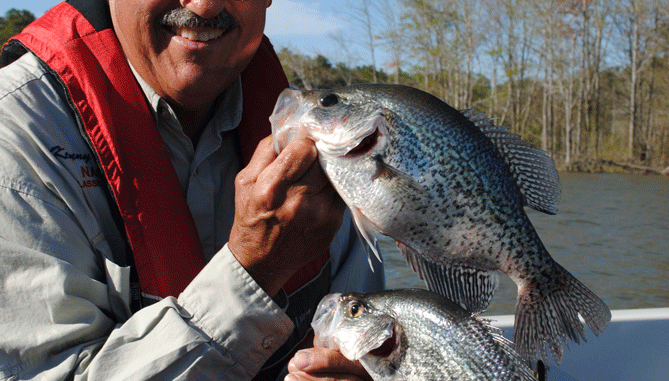
Creel and size limits have made Jordan Lake, one of North Carolina’s best crappie fisheries, even better — at least according to one crappie pro.
A lot of anglers might think that Kenny Allen of Brown Summit missed out on the heyday of crappie fishing at B. Everett Jordan Lake in the 1990s, a decade after the reservoir opened and was quickly labeled one of the Southeast’s best fisheries for both crappie and largemouth bass.
Allen, a pro crappie fisherman, spent plenty of time on Jordan after it was impounded in the early 1980s, then Brown & Williamson Tobacco Company moved him to Macon, Ga.,
When Reynolds Tobacco Company bought Brown & Williamson, they moved Allen “home” in 2005, and he set out to fish all the lakes within driving distance of his Guilford County home. He settled on Jordan as his favorite and can’t imagine that fishing could have been better on the 13,900-acre reservoir than it is now.
“That 10-inch (minimum size) limit, that’s made this lake,” said Allen, who has fished for crappie on reservoirs all over the Southeast on various tournament circuits but has never found one he like better than Jordan.
“Jordan is about as good as it gets,” he said. “I love it; it’s my favorite crappie lake. There are so many good fish. That 10-inch limit has done it.”
The N.C. Wildlife Resources commission started experimenting with size and creel limits for crappie on its lakes across the Piedmont just after 2000, but Jordan was the last to get any restrictions, in mid-2004. And while 8-inch size minimums and 20-fish creel limits were the norm, Jordan got a 10-inch size minimum.
According to Corey Oakley of Mebane, a fisheries biologist for the Commission, the regulation change has improved Jordan as a crappie fishery.
“Thirty percent of crappie in this lake are 10 inches or longer, and in the world of crappie, if you get 30 percent over 10 inches, you’ve done pretty well,” he said.
Allen thinks that Jordan’s shad population really drives the crappie fishing — “In the evening you should see the seagulls,” he said — guaranteeing great grown rates and plenty of big fish.
And those big fish start to get easier to catch this month, as the spawn arrives at Jordan. For the better part of the next six weeks, crappie are likely to be on the way to the bank to spawn, spawning and moving out of the shallows after spawning.
“In March, they’re going to start out in deeper water, 18 to 25 feet, out in the mouth of the creeks,” Allen said. “They’ll start moving back in the creeks when the water temperature gets to about 52 or 53 degrees. What I really like is when it gets to about 56. That’s when it gets hot.
“A crappie is a predator; he’s gonna go where he feels comfortable – creek channels and creek bends. They migrate a lot, and they’ll be ganged up early this month until the water temperature gets to 54, 55, 56 degrees.
“The old black crappie come in first and make their beds, then the whites. They’ll be about a week apart. You usually don’t catch blacks and whites together in March, but when you find the whites, they’re there. The whites will get bigger, but you can catch both of them the same size in Jordan.”
Allen works the creek mouths first. He likes the mouth of White Oak and No Name creeks, both upstream from the US 64 causeway and bridge, and he really likes to fish the deep water at the mouth of Stinking Creek. For big concentrations of fish, go early in the month before the weather warms too much and the fish start to spread out.
“The first of March (last year), I had 13 2-pound fish in one day,” Allen said. “The bigger fish come in and out at different times, but I think the biggest fish have spawned by the first of April.”
Like most pro fishermen, Allen goes with the multi-rod trolling technique known as “spider rigging.” When he’s fishing by himself, he’ll use his electric trolling motor to govern his course and speed, and he fishes eight rods. He’ll have four rods out on either side of the transom: 16-footers on the outside, 12-footers just inside them and a pair of 8-footers closest to the outboard motor on each side.
Rolling into a creek, he’s essentially dragging baits through a 40-foot wide swath of water. He’ll speed up or slow down to vary the depths his baits run, paying attention to which baits, fished at which depths, draw the most strikes so he can key in and develop a pattern that produces even more fish.
Allen likes to fish tandem rigs of tiny leadhead jigs and colorful mini-jigs. He’ll fish a heavier jighead in front to make sure the rig tracks straight through the water.
“I like to fish double rigs,” he said. “People say they’re too much trouble, but you catch more fish. I like to fish a jig one or two sizes smaller in the back — 1/16th-1/32nd or 1/16th-1/64th (ounce) — to get the depth right. I like a round-head (jig) in the front and a minnow-head in the back, because it will always dive a little bit deeper.
He’ll fish all styles and makes of mini-jigs, from Garland and Slider to AWD, Southern Pro, Kalin and Crappie Delights, looking for the right combination of depth, style and color that slabs prefer that particular day. If he catches most of his better fish on the shallow side of his boat, he might edge toward that side slightly, and vice versa, or speed up just a tiny bit to get his baits to run slightly closer to the surface. Another thing he does to ensure success is thread a PowerBait Crappie Nibble — a tiny, cylindrical-shaped scented attractant that comes in a marshmallow consistency — on the leadhead’s hook, right in the bend where it won’t hurt the action of whatever piece of plastic is being fished.
Allen expects to do the most damage up in the day, after the sun ahs had a chance to warm the water slightly.
“You’ll catch some big fish early, but most of the time, they’re better up in the day,” said Allen, who usually trolls at around 1 mph. “I’ve seen it slow in the morning, then I had to speed the boat up later in the day because they’d gotten so active.
“Sometimes, I’ll slow it down a little, then speed it up a little, and they’ll chase those baits.”
DESTINATION INFORMATION
HOW TO GET THERE — Jordan Lake is southof Chapel Hill and Durham and southwest of Raleigh, roughly 10 miles east of Pittsboro along the border between Chatham and Wake counties. Jordan Dam, near Moncure, impounds the Haw and New Hope rivers. US 64 crosses Jordan at mid-lake, and NC 751 is a popular road that runs north-south several miles east of the lake. Public boat ramps are plentiful; popular ones include Ebenezer on NC 1002 on the east side of the lake, Seaforth just off US 64 on the west side of the lake and Crosswinds just off US 64 on the east side of the lake, plus Farrington Point off NC 1002 on the upper end of the lake and White Oak off NC 1002 barely a mile north of US 64.
WHEN TO GO — March and early April are the peak times for catching big crappie and good numbers of them. Crappie start to move back in major creeks in early March and head for the banks to spawn when the temperature approaches 60 degrees. Most spawning is done by early April, although some fish will stay relatively shallow until the first of May.
TACKLE/TECHNIQUES — Fishermen can use live minnows or mini-jigs under floats and work the shoreline successfully, but more and bigger crappie will be caught by slow-trolling mini-jigs on multiple-rod rigs known as “spider-rigging”. Light spinning outfits and light line are the ticket to getting the best action from jigs of various colors and configurations.
FISHING INFO — Wilsonville General Store 10580 US 64 E, Apex, 919-362-7101; Crosswinds Marina, 919-362-5391. See also GUIDES & CHARTERS in Classifieds.
ACCOMMODATIONS — Comfort Inn, 1411 E. Williams St, Apex, 919-387-4600; Holiday Inn Express,1006 Marco Drive, Apex, 919- 387-3636. Camping is available at Jordan Lake State Recreation Area, 280 State Park Rd Apex, 919-362-0586.
MAPS — GMCO Maps, 888-420-6277, http://www.gmcomaps.com/; Kingfisher Maps, 800-326-0257, http://www.kfmaps.com/.

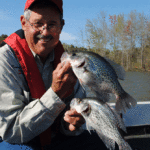
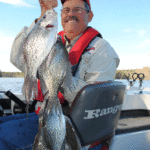
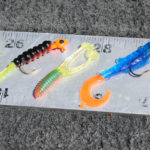

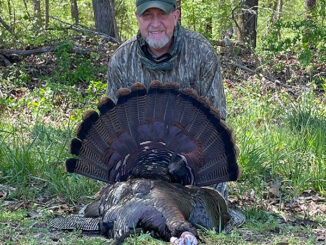
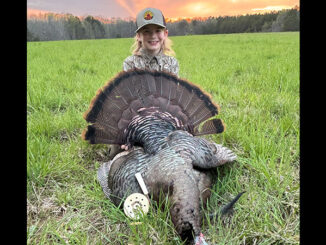

Be the first to comment